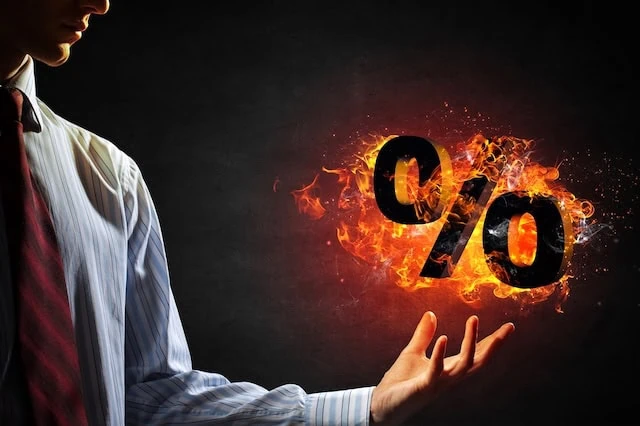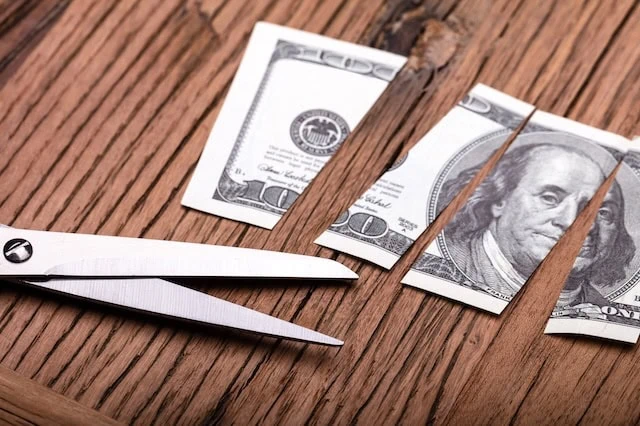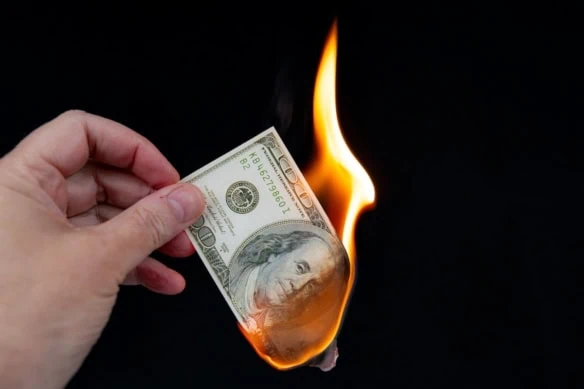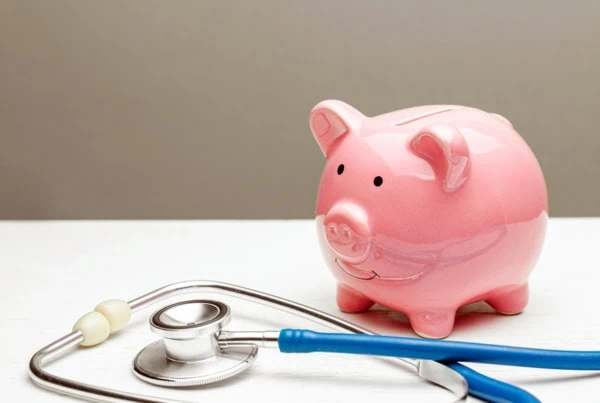The power goes out in your home. You can’t find the six flashlights your uncle gave you for Christmas, so you start to light some candles. But as the power outage drags on, you start to wonder how much longer your candles can burn.
People who lose their job find themselves in a similar situation. When an income source evaporates, people are forced to burn through their savings—and the longer they remain unemployed, the more worried they become that their savings won’t last.
Today, I’m going to introduce you to the concept of savings burn rates. It’s a simple idea, but it’s important to understand if you want to plan for bad-case financial scenarios. So, I’ll explain how it works, how to calculate it, and how to improve it.
Featured Financial Products
What Is a Savings Burn Rate?

The term burn rate is a business term that can apply to one’s personal finances as well.
“Burn rate” refers to how much cash a company consumes in a certain period, commonly monthly, to cover all of their expenses. Most commonly, it’s used to discuss companies that are unprofitable and must “burn” the capital they’ve raised until they start generating profits and positive cash flow.
However, burn rate can also be applied to your household budget. Your savings burn rate tells you how much you spend in a given month to cover your monthly expenses, and thus how long your savings would last.
Why Is Knowing My Savings Burn Rate Important?

You never know when you’re going to lose your job or other sources of income.
You might be laid off. You might need to quit to care for a sick family member. You might go through some other sort of disruptive life event.
Whatever the reason, if you’re no longer bringing in enough money to fully cover your monthly expenses, you’ll need to rely on your emergency fund and other savings. Your savings burn rate informs you how long your emergency fund/savings would last, which gives you an idea of how urgently you need to find a new income source. If your savings would last for, say, a year, you could take your time and try to find a job that checks off a lot of your ideal boxes. If your savings would last for something closer to a month, you might not have the ability to be as selective—and/or you might need to consider getting a side gig in the interim.
Don’t wait until disaster strikes calculate your savings burn rate. Calculate it ahead of time so you can plan your finances accordingly. It’s commonly recommended for your emergency fund to hold enough money to last you a minimum of three to six months. If your burn rate shows that you would burn through your savings more quickly than that, you may want to prioritize building up your emergency fund more.
How to Calculate Your Savings Burn Rate

Calculating your burn rate is as simple as it gets:
Add up all your monthly expenditures.
That’s it. Just take a look at your bank and credit card statements, look at your checkbook if you still use one, and add up everything that you spent.
Of course, chances are your spending habits would change if you were laid off. So, you might instead want to calculate what your burn rate would be if you lost your job and you limited yourself to only essentials. Again, to do that, you would just add up the costs of all vital expenses such as rent/mortgage, utilities, transportation, food, medicine, etc. And remember: You might have a stray essential expense that’s on a different schedule, such as quarterly or annually, so make sure to factor those in too.
However many months of expenses your savings would cover at your calculated burn rate is your cash runway.
Let’s look at an example.
Related: Budgeting Priorities If You’re Laid Off
Burn Rate / Cash Runway Example

Here’s an oversimplified example just to give you an idea of how this is done.
Let’s say this is what your monthly essential expenses looked like:
- Rent: $1,900
- Utilities (including internet): $400
- Auto payment: $350
- Auto insurance: $150
- Phone: $100
- Groceries: $450
- Prescription medicine: $50
Your burn rate would be $3,400 per month.
So, let’s say your emergency fund had a $10,000 balance. You would have a cash runway of roughly three months. (10,000 savings / 3,400 burn rate = 2.94 months)
Put differently: You’d have about three months’ worth of expenses covered.
That is, of course, assuming a few things. For one, this assumes no emergencies—such as needing a major car repair—arise in the meantime. It also assumes that grocery prices will remain the same. Your prescription costs might differ, too, if you lose your health insurance when you lose your job. (Though programs such as GoodRx can help limit the cost of some prescriptions.)
If your runway feels too low, you might want to take action to build your savings.
Related: Tax Implications of Getting Laid Off
How Can I Improve My Burn Rate and Runway?

The only way to improve your burn rate is to spend less money each month.
When it comes to budgeting for a potential layoff or other bad-case income scenario, the most effective thing you can do to quickly reduce burn rate is to knock out discretionary spending, such as eating out at restaurants and streaming TV subscriptions.
There are a few things you can do to reduce essential spending—being more cost-conscious when you shop for groceries, or being more prudent about electricity usage in your home—but at the end of the day, you still need a roof over your head and food in your mouth, and that requires some baseline of money to achieve.
If part of your essential expenditures is debt, such as a credit card, student loan, even a mortgage, you might be able to get on a debt repayment plan or get forbearance from your lender. These arrangements can help you temporarily pause or reduce your payments.
Meanwhile, there are only three ways to improve your cash runway:
- Lower your burn rate (see above).
- Build your savings (only applicable while employed). You could start by allocating more of your current income into savings, or getting a temporary side hustle and pushing all of the money earned through your gig into an emergency fund.
- Find sources of income (while laid off). Even if you can’t find a full-time job right away, a side hustle, even unemployment insurance benefits, could provide at least some cash flow and slow how quickly you burn through your savings.
Featured Financial Products
Related: How to Achieve Financial Minimalism to Reduce Stress





![How to Get Free Money Now [13 Ways to Earn Money Today] 12 how to get free money](https://youngandtheinvested.com/wp-content/uploads/how-to-get-free-money-600x403.webp)

![8 Best Debit Cards for Teens [Reviewed by a CPA + Father] 14 best debit cards for teens hires](https://youngandtheinvested.com/wp-content/uploads/best-debit-cards-for-teens-hires-600x403.webp)
